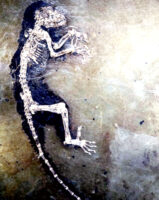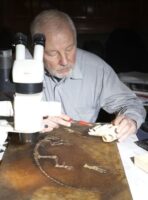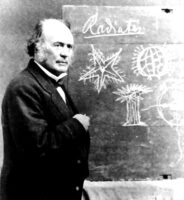 This is the story of the Ida Fossil Fiasco. “This little creature is going to show us our connection with the rest of all the mammals, with cows and sheep, and elephants and anteaters,” said Sir David Attenborough, who narrated the BBC documentary in May 2009.
This is the story of the Ida Fossil Fiasco. “This little creature is going to show us our connection with the rest of all the mammals, with cows and sheep, and elephants and anteaters,” said Sir David Attenborough, who narrated the BBC documentary in May 2009.
“The more you look at Ida, the more you can see, as it were, the primate in embryo.”
Really? According to Jørn Hurum, the paleontologist from Oslo University’s Natural History Museum, who assembled the scientific team –
“It tells a part of our evolution that’s been hidden so far. It’s been hidden because the only [other] specimens are so incomplete and so broken there’s almost nothing to study.”,
The fossil findings were released to the world at a press conference in New York, simultaneously with the online publication of the paper in the Public Library of Science (PLoS ONE) on May 19, 2009.
Writing the Story
Leading author Jens Frazen of the Natural History Museum in Basel, Switzerland, entitled the paper “Complete Primate Skeleton from the Middle Eocene of Messel in Germany: Morphology and Paleobiology.” At the opening press conference, the fossil was described as the “missing link” in human evolution. “This fossil rewrites our understanding of the evolution of primates… It will probably be pictured in all the textbooks for the next 100 years”, claimed the Ida investigative team. Ida was interpreted as our “human ancestor”—the first and only one known.
opening press conference, the fossil was described as the “missing link” in human evolution. “This fossil rewrites our understanding of the evolution of primates… It will probably be pictured in all the textbooks for the next 100 years”, claimed the Ida investigative team. Ida was interpreted as our “human ancestor”—the first and only one known.
The fossil had even been formally named Darwinius masillae in honor of Darwin’s 200th birthday year in 2009. Franzen claimed Ida was “the 8th wonder of the world”.
The widely publicized Darwinius paper was released along with a book entitled The Link: Uncovering Our Earliest Ancestor, a DVD entitled The Link, This Changes Everything, a History Channel documentary, and an exhibit in the American Museum of Natural History. At a news conference attended by New York Mayor Michael Bloomberg, the authors unveiled the nearly complete Darwinius masillae fossil found in Germany. The New York Daily News noted,
“The unveiling of the fossil came as part of an orchestrated publicity campaign unusual for scientific discoveries.”
Re-Writing the Story
 As the Darwinian celebrations were sinking into the sand by the end of 2009, however, so was the “missing link” status of Ida as scientists continued to analyze the fossil. By October 2009, the BBC retracted their position, running ran an article entitled “Primate Fossil ‘Not an Ancestor,’” stating –
As the Darwinian celebrations were sinking into the sand by the end of 2009, however, so was the “missing link” status of Ida as scientists continued to analyze the fossil. By October 2009, the BBC retracted their position, running ran an article entitled “Primate Fossil ‘Not an Ancestor,’” stating –
“The exceptionally well-preserved fossil primate known as “Ida” is not a missing link as some have claimed.”
The fossil fiasco was finally formalized with the March 2010 article in the Journal of Human Evolution by paleontologists Blythe Williams et al, entitled – “Darwinius masillae is a strepsirrhine—a reply to Franzen et al. (2009),” noting –
“Franzen et al. (2009) make a strong case that Darwinius is an adapiform, but none of the characters they invoke provide support for the hypothesis that Darwinius (or any other adapiforms) are stem haplorhines.”
confirming initial suspicions that the original description of Darwinius, which appeared in the journal PLoS One, was fatally flawed.
Why
The updated analysis by Williams and team members painted a damning picture of the original Darwinius study. The team reports that the features of bones in the skull, teeth, and limbs clearly demonstrate that Ida is not even a primate—certainly not a human ancestor.
In March 2010, news editor for the New Scientist, Rowan Hooper, published the article entitled Confirmed: Fossil Ida is Not a Human Ancestor stating, “About a year ago, we were stunned in the New Scientist offices to learn of a beautiful, 47-million-year-old primate fossil which was being hyped as the ancestor to all humans. Nicknamed ‘Ida’, The Guardian newspaper hailed it as “the eighth wonder of the world… Now an independent team has examined the fossil in detail. In a paper in the Journal of Human Evolution, they strongly argue that Darwinius is not one of our ancestors.”
The Ida fossil announcement in PLoS ONE followed the same pattern as the Archaeoraptor fossil disaster announcement in National Geographic magazine in 1999. This pattern follows a strict evolutionary paradigm approach where ideology drives the interpretation. Ida serves as yet another example of how evolution by means of the natural selection paradigm distorts and stifles scientific investigation and undermines the credibility of the modern scientific establishment.
Rewriting Evolution History
Ida and Archaeoraptor join a long line of fossil fiascoes, including Archaeopteryx, Java Man, and the Piltdown Man. Fossil fraud and deception by the evolution industry continue to pervade the history of evolution, perhaps because the fossil record continues to intensify Darwin’s dilemma developed in the Origin of Species.
“No wonder paleontologists shied away from evolution for so long,” pines Niles Eldredge, evolutionary paleontologist. “It seems never to [have] happen[ed].”
Douglas Futuyma, president of the Society for the Study of Evolution and the American Society of Naturalists, editor of Evolution, abandoned Darwinism, stating,
“The supposition that evolution proceeds very slowly and gradually, and so should leave thousands of fossil intermediates of any species in its wake, has not been part of evolutionary theory for more than thirty years.”
Darwin’s Dilemma intensifies.
Genesis
 Ida’s fossil highlights why evolution remains a theory in crisis. While the fossil record evidence continues to contradict the Darwinian theory of evolution, the fossil record is compatible with the Genesis account written by Moses.
Ida’s fossil highlights why evolution remains a theory in crisis. While the fossil record evidence continues to contradict the Darwinian theory of evolution, the fossil record is compatible with the Genesis account written by Moses.
Jean Louis Rodolphe Agassiz, a Swiss-American biologist and geologist, credited for developing the Ice Age concept, explains how ideas sometimes advance during the Scientific Revolution –
“Every scientific truth goes through three stages: first, people say it conflicts with the Bible; next, they say it has been discovered before; lastly, they say they always believed it.”
Evidence for common ancestry and transitional links underscores why the theory of evolution remains speculative but not scientifically valid.
Ida Fossil Fiasco is a Fossil Record article.
Darwin Then and Now is an educational resource on the intersection of evolution and science, highlighting the ongoing challenges to the theory of evolution.
Move On
Explore how to understand twenty-first-century concepts of evolution further using the following links –
-
- The Understanding Evolution category showcases how varying historical study approaches to evolution have led to varying conclusions. Subcategories include –
- Studying Evolution explains how key evolution terms and concepts have changed since the 1958 publication of The Origin of Species.
- What is Science explains Charles Darwin’s approach to science and how modern science approaches can be applied for different investigative purposes.
- Evolution and Science feature study articles on how scientific evidence influences the current understanding of evolution.
- Theory and Consensus feature articles on the historical timelines of the theory and Natural Selection.
- The Biography of Charles Darwin category showcases relevant aspects of his life.
- The Glossary defines terms used in studying the theory of biological evolution.
- The Understanding Evolution category showcases how varying historical study approaches to evolution have led to varying conclusions. Subcategories include –


